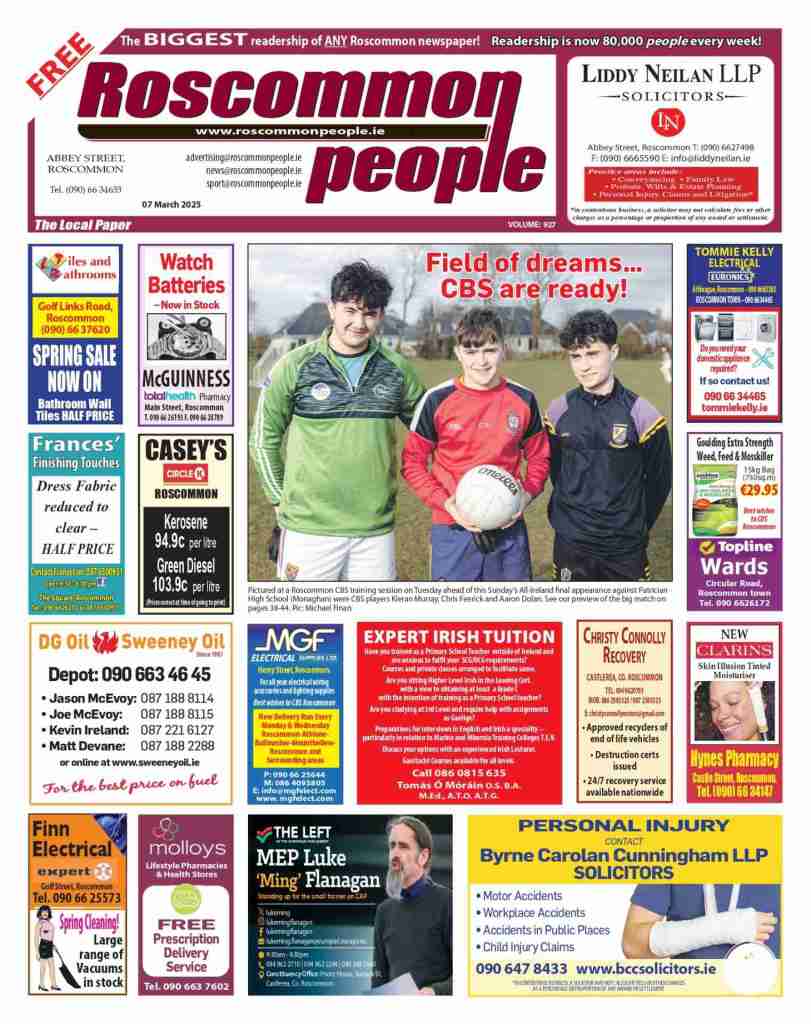Let’s talk about… Culture Night and Garda policing
Celebrating culture amid cultural division
As a country, we recently celebrated Culture Night 2024 – a national event held annually in celebration of the richness and diversity of Irish culture.
Every year, Culture Night is celebrated with a variety of events hosted by different groups across the country. In fact, I’m sure many readers will have attended one such event in County Roscommon – be it a performance, lecture, social event, workshop, exhibition, etc. One of the great appeals of Culture Night is this variety it presents; a programme as multi-faceted as the amalgamation of cultures, traditions, and identities it aims to honour.
In a time of heightened tensions and intolerance around cultural divides, Culture Night has another unique appeal; it is a safe haven from the politicisation of culture. Or at least, it is theoretically – ideally. It is intrinsically intended to be a wholehearted and uncompromised celebration of all that makes up culture in Ireland – important now more than ever.
In recent times, we have seen cultural divisions heighten in this country, due in no small part to the increased polarisation and extremism prompted by the wave of xenophobia, racism, and anti-immigration sentiment we see consistently and increasingly peddled by far-right agitators. An event like Culture Night, aiming to unify people in Ireland rather than divide them, is a special positive force in the face of this.
Culture Night is about more than the different identities that make us up – it’s about our art, our history, our entertainment, etc too – but at its core, Culture Night represents an earnest and just attempt to recognise and value the rich cultural diversity of modern Ireland, and to support the coming together of all the country’s different communities – which is why it is such a pity that one of the bigger stories to come from this year’s event was one alleging systemic inequality… on the basis of race and culture itself.
Policing Culture Night or over-policing culture?
On Friday, September 20th, Tola Vintage – a black-owned business based in Dublin – held their annual Culture Night block party at their flagship store on Fownes Street. Though not an official Culture Night event, this was the fourth year the party was held, with Tola Vintage confirming in the aftermath that they’ve always sought neighbours’ permission to host it. In previous years, the party has been an out-and-out success, running without a hitch. Per a statement from Tola Vintage, “The event always wraps up by 11.30 (pm), and everyone helps clean up the street”.
However, this year, the party came to an abrupt end when things quickly descended into chaos following the Gardaí’s arrival at the scene.
Gardaí stated they’d become aware of “public safety concerns” in relation to the gathering, saying the large crowd in attendance was “unsuitable for the street capacity”.
According to the Garda Press Office, “Gardaí initially engaged with the management of the premises with a view to managing the situation but received limited support” – but according to a manager at Tola Vintage, Ayuba Salaudeen, efforts were made to cooperate with Gardaí requests.
Speaking to Trinity News, Salaudeen said that at around 9.30 pm on the night, Gardaí “told us to turn off the music, which we did”. A conversation then ensued about dispersing the crowd to let a Garda van through, with Salaudeen saying organisers “were on the mic to tell people, ‘It’s over, they want us to clear the street’”.
“They (the Gardaí) said we tried to turn the music back on, but we weren’t”, Salaudeen stated. “They said, ‘Actually, move the crowd now’”.
Reportedly, after asking Gardaí to “give us a few minutes to move the crowd” safely, and before staff were able to get back on the microphone and confirm to attendees that they needed to disperse, “about ten of them (Gardaí) just rushed. It just kicked off from there”.
What followed was a series of chaotic and disturbing scenes, in which Gardaí clashed with attendees, levelling what many have described as an unnecessarily “heavy-handed” approach to dispersing the crowd. Three people were arrested and several suffered acute injury. In footage shared online, Gardaí can be seen engaging in a number of violent altercations – one clip sees multiple Gardaí crowding around and subduing one man with force as witnesses shout, “He’s bleeding”.
The incident sparked a slew of discourse, with various advocacy groups voicing concerns about why Tola Vintage’s event specifically – an event hosted by black organisers with a majority of POC (people of colour) attendees – received such heavy-handed policing, when similar events were happening in similar locations concurrently, and when, according to Salaudeen, the event saw the “same size” crowd in attendance it had in previous years.
These groups expressed concerns about what the incident represents regarding how minorities are policed in Ireland, stating that black communities and businesses routinely experience unjust treatment.
Representative group ‘Black and Irish’ stated that they were “deeply concerned by the footage”: “We share the sense of disappointment many creatives and event-goers feel surrounding social life in Ireland”. The group, alongside the owner of Tola Vintage, said it would be meeting with the Gardaí to discuss the incident this week (the first week in October).
Of course it goes without saying that this is far from the only time the Gardaí’s over-policing of ethnic minority communities has been highlighted recently. In fact, as sobering as some of the Tola Vintage footage was, it isn’t even the most damning in terms of exemplifying the issue – take the Irish Council for Civil Liberties and Irish Network Against Racism’s detailed report from earlier this year, which comprehensively outlined minority communities’ experiences of discrimination when interacting with Gardaí.
Details are continuing to emerge regarding what happened at Tola Vintage on Culture Night, as are disagreements over why it happened. For all who consider this incident as yet another example of the covert de-jure over-policing of minorities, there are those who consider it as solely an issue of public order, with nothing to do with race at all – and for all the legitimacy there is in asking questions about what happened and why, such questions will undoubtedly be better answered following the Tola, Black and Irish, and the Gardaí’s meeting and the light it will (hopefully) shed on the matter.
But in the meantime, it is hard not to juxtapose the difference between the robust public order approach taken at an established, organised celebration hosted and attended by people of colour, and the distinctly calmer one that’s often taken at the likes of, say, violent anti-immigration demonstrations.
Who gets guarded and who gets policed?
This summer saw far-right anti-immigration demonstrations reach new heights – and new lows. As their frequency have increased, these protests have only become more dangerous; sites for asylum seekers set on fire, people of colour verbally and physically abused.
RTÉ’s brand-new documentary ‘Inside The Protests’ tackles this subject, and includes scenes like demonstrators physically pushing, intimidating, and hurling insults at a journalist in front of several Gardaí, who do not intervene.
Even outside of anti-immigration protests, there has been a growing general feeling that violent and hateful offenders receive too lenient policing. Arguably, after all, if Gardaí are happy to quite literally stand by and watch as hateful demonstrators behave violently, their role begins to feel a lot more like guarding demonstrators rather than policing them.
The reserved Garda response at these protests is, supposedly, in line with the ‘hands-off’ approach that Justice Minister Helen McEntee has backed and defended on several occasions; much to the waning disillusionment of an Irish public now sick to the teeth with examples of chaotic and violent demonstrations and riots.
The feeling from the Irish public is that appropriate public order enforcement from our Gardaí is not just warranted, but overdue. Which is why even those dubious that race played any role in the Tola Vintage
incident have been able to condemn the Garda response; because how is it that the Gardaí cracked down so heavily on a Culture Night celebration no one was being harmed by, but remain calm to the point of negligence when it comes to actual displays of violence?
The disparities and inconsistencies between which groups are guarded by the Gardaí’s public order approach and which groups are policed – or indeed over-policed – are unignorable, and change is urgently needed.
It’s become blatantly obvious that the current framework and practices in operation are not just unfair, they’re nonsensical. Because after all, between the Tola Vintage incident and the recent riots, a bizarre question arises: given today’s culture in Ireland, is it safer to throw a punch or a party?






